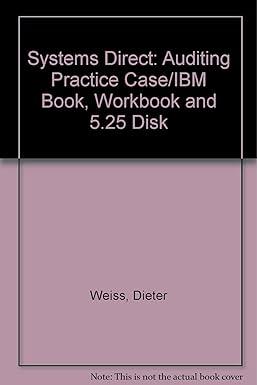Question
On January 1, 2016, Monica Company acquired 80 percent of Young Companys outstanding common stock for $728,000. The fair value of the noncontrolling interest at
On January 1, 2016, Monica Company acquired 80 percent of Young Companys outstanding common stock for $728,000. The fair value of the noncontrolling interest at the acquisition date was $182,000. Young reported stockholders equity accounts on that date as follows:
| Common stock$10 par value | $ | 300,000 | |
| Additional paid-in capital | 70,000 | ||
| Retained earnings | 430,000 | ||
In establishing the acquisition value, Monica appraised Young's assets and ascertained that the accounting records undervalued a building (with a five-year remaining life) by $70,000. Any remaining excess acquisition-date fair value was allocated to a franchise agreement to be amortized over 10 years.
During the subsequent years, Young sold Monica inventory at a 30 percent gross profit rate. Monica consistently resold this merchandise in the year of acquisition or in the period immediately following. Transfers for the three years after this business combination was created amounted to the following:
| Year | Transfer Price | Inventory Remaining at Year-End (at transfer price) | |||||||
| 2016 | $ | 40,000 | $ | 12,000 | |||||
| 2017 | 60,000 | 14,000 | |||||||
| 2018 | 70,000 | 20,000 | |||||||
In addition, Monica sold Young several pieces of fully depreciated equipment on January 1, 2017, for $38,000. The equipment had originally cost Monica $54,000. Young plans to depreciate these assets over a 5-year period.
In 2018, Young earns a net income of $160,000 and declares and pays $35,000 in cash dividends. These figures increase the subsidiary's Retained Earnings to a $760,000 balance at the end of 2018.
Monica employs the equity method of accounting. Hence, it reports $119,760 investment income for 2018 with an Investment account balance of $921,200. Under these circumstances, prepare the worksheet entries required for the consolidation of Monica Company and Young Company. (If no entry is required for a transaction/event, select "No Journal Entry Required" in the first account field.)
1. Prepare Entry *G to recognize upstream intra-entity inventory gross profit deferred from the previous year.
2. Prepare Entry *TA to return the equipment accounts to beginning book value based on historical cost.
3. Prepare Entry *C to adjust the parent retained earnings for the subsidiary's increase in book value.
4. Prepare Entry S to eliminate the stockholders' equity accounts of the subsidiary and recognize the noncontrolling interest.
5. Prepare Entry A to recognize the amount paid within acquisition price for buildings and the franchise agreement.
6. Prepare Entry I to eliminate the intra-entity income accrual.
7. Prepare Entry D to eliminate the intra-entity dividend transfers.
8. Prepare Entry E to remove the intra-entity inventory transfers made during the current year.
9. Prepare Entry TI to defer the intra-entity gross profit on the 2018 intra-entity inventory transfers.
10. Prepare Entry G to defer the intra-entity gross profit on the 2018 intra-entity inventory transfers.
11. Prepare Entry ED to remove the current year depreciation on the transferred item since its historical cost has been fully depreciated.
Step by Step Solution
There are 3 Steps involved in it
Step: 1

Get Instant Access to Expert-Tailored Solutions
See step-by-step solutions with expert insights and AI powered tools for academic success
Step: 2

Step: 3

Ace Your Homework with AI
Get the answers you need in no time with our AI-driven, step-by-step assistance
Get Started


